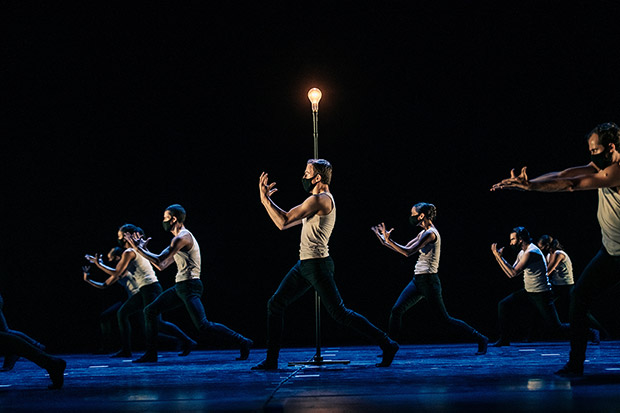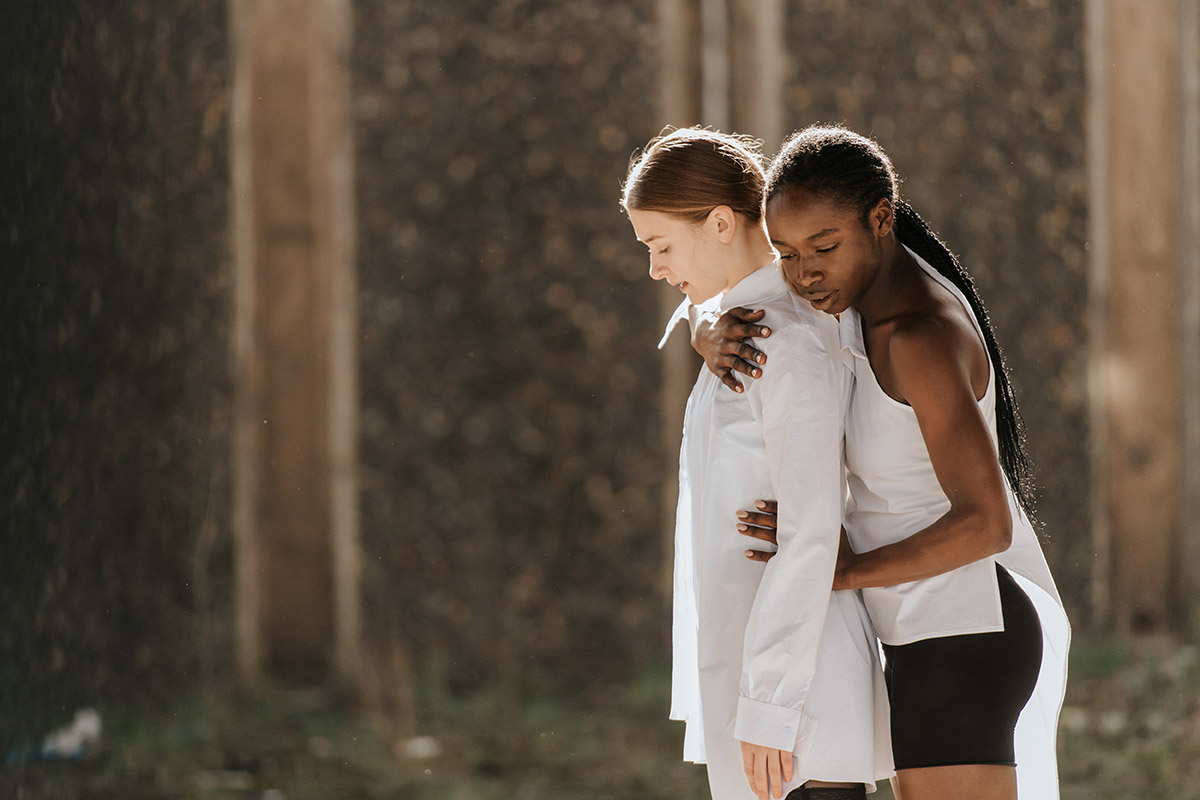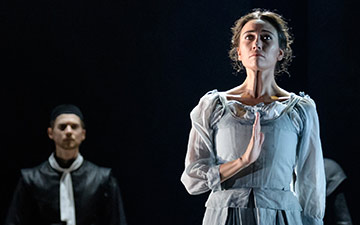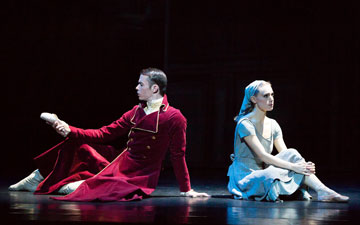
© Mihaela Bodlovic. (Click image for larger version)
Scottish Ballet
An Evening with Scottish Ballet
Streamed as part of the Edinburgh International Festival opening programme, My Light Shines On
★★★✰✰
8 August 2020
www.scottishballet.co.uk
See on YouTube
For the first time in 73 years, the Edinburgh Festival has been unable to take place in the city. On what would have been the opening night this year, the Festival offered films and streamings of commissions from its national companies. An Evening with Scottish Ballet consisted of six short films, made at different times under different conditions.
A spoken introduction by artistic director Christopher Hampson would have been helpful, explaining (as he often has before Scottish Ballet events) the context of each film’s creation. Some had been made for the company’s inventive Digital Seasons, when choreographers were invited to make use of video technology. Others were recently recorded under lockdown conditions, including the special commission for the Festival, Catalyst, filmed in the empty Edinburgh Festival Theatre.
The first film was as baffling as its title, Prometheus and Epimetheus. A male couple (Barnaby Rook Bishop and Thomas Edwards) and a female pair (Grace Horler and Grace Paulley) were filmed in a dance studio, performing the same choreography by Alexander Whitley. It was impossible to follow because the duets, separately recorded under lockdown, were intercut and the camera, directed by Michael Sherrington, moved dizzyingly around the room.
To find the concept behind the work, commissioned for the 2019 Digital Season, you need to look at Whitley’s website: www.alexanderwhitley.com/prometheus-epimetheus.
Whitely, artistic director of his own company, collaborated with artist Zachary Eastwood-Bloom to co-create a duet about mythical brothers, representing forethought and afterthought, bound together by digitally generated ties to their limbs. They and the technology linking them are in perpetual conflict and negotiation, thanks to motion capture. The stunning 2019 video is more intriguing to watch than the its non-digital version (see below), an off-putting opener for the programme.
Prometheus and Epimetheus from Alexander Whitley on Vimeo.
The next two duets were also recorded during lockdown. Trace had been made in 2013 by Helen Pickett, the American choreographer who created the full-length ballet The Crucible for the company, given its premiere at last year’s Edinburgh Festival. At first, I had assumed that Trace was a pas de deux for two women, until I realised that the long-haired partner (who resembles the former Royal Ballet star Zenaida Yanowsky) is in fact Rimbaud Patron, dancing with his fiançée, Claire Souet. She is on pointe, in a skimpy leotard, while he wears jeans and a long-sleeved top. Their duet is a negotiation, a dialogue of embraces, as their moods change with the piano music, Rachmaninov’s Prelude no 4. She is contrary, passionate, enticing; he is adoring and exasperated. It’s a lovely pas de deux.
Sophie Laplane’s Oxymore (2013) features two women, Rishan Benjamin and Anna Williams, dancing alongside each other, deadpan but acutely aware of the other’s presence. They were filmed by Sherrington’s roaming camera in the company’s loading bay, among crates and pallets. Both women wear identical tops and loose stretchy trousers, which they pull out at the sides like clowns’ pants. Hypnotically, the pair throb and pulse to the rapid percussive soundtrack by Susuu Yokota. Their detailed semaphore is sometimes in sync with each other, at other times going their own way, as if in a dance trance.
Laplane’s larger work, Idle Eyes, also uses fast robotic electronic music, by the duo Emptyset. Her cast of company dancers and Youth Exchange members appear to be performing gaming and mating rituals, in a fuchsia-lit playground. Their pounding moves are cruder than those in Oxymore. Maybe they are a pack of adolescents, suddenly dispersed by a loud sneeze on the soundtrack. Idle Eyes, made in just a week for the 2019 Digital Season, is the least polished piece in the programme.

© Mihaela Bodlovic. (Click image for larger version)
The most elaborate is Frontiers, directed (like Idle Eyes) by Eve McConnachie, Scottish Ballet’s resident film maker, in association with Sherrington and Forest of Black production company. The choreography is by Myles Thatcher, a dancer and prolific choreographer with San Francisco Ballet. Commissioned to make a piece for the 2019 Digital Season, he chose to question the stereotypes of classical ballet by intercutting gender-neutral partnering. Multiple camera shots chop and change between six dancers, performing variations of the same choreography in different combinations beneath the brutalist concrete flyovers of Glasgow’s motorways. In this short film, there isn’t time to register the impact of alternative gender pairings.
Challenging it isn’t, since same-sex partnering is not uncommon in contemporary dance, and these performers wear sneakers and street clothes, not tights and pointe shoes. Though some lifts are balletic, they’re nothing like those in Pickett’s Trace. Yes, there is a sense of clandestine isolation in this underbelly setting, and the faces, especially that of Rishan Benjamin, who starts and ends Frontiers, are haunting. Apart from her, however, the dancers aren’t seen as individuals, so the merging of their identities by rapid editing is hardly confounding.
The final offering, Catalyst, was filmed on stage in the empty Festival Theatre on 4 August, the first time the dancers were united since lockdown. (Rehearsals had taken place in separate bubbles.) Company soloist Nicholas Shoesmith, who was commissioned to create a work for a large number of dancers, sees it as ‘a gesture of creative resilience’ in trying conditions.
A single outsize light bulb appears to illumine the stage as a male dancer in a mask, Thomas Edwards, enters – the catalyst who will set a reaction in train. More and more figures emerge, identically dressed in white singlets and black leggings, all wearing black facemasks. They are separated by squares of light on the dance floor, as though in a company ballet class. Their moves, though, like those in previous films, pulsate in contemporary dance style to electronic music, in this case by Ben Chatwin, The Secrets of the Sky.

© Mihaela Bodlovic. (Click image for larger version)
As the music increases in in sonority, the corps of dancers crouch and curve in unison with growing determination and defiance. They resemble a flock of sea birds, elbows pointing upwards like wings. However much they unfurl upwards, they cannot take flight, rooted to their spots. They wrap their arms around themselves like straitjackets, heads pecking and turning. A camera shot from high above shows them beached on the stage, confronting an ocean of empty seats. As the music diminishes, dancers leave until Edwards is alone once more. The light bulb goes out.
It’s an effective though melancholy end to the half-hour programme that was meant to be alleviated by including the bonkers ballet film, Tremble, made for the company’s Digital Season in 2019 by Jess and Morgs (Jessica Wright and Morgann Runacre-Temple).
Set in a surreal dining hall, it features 26 hyperactive waiters, waitresses and customers coping with wobbly jellies. (Araminta Wraith wrote about its creation in a 2018 blog for Dance Tabs: dev-dancetabs.mystagingwebsite.com/2019/06/araminta-wraith-scene-on-screen-life-behind-the-lens-at-scottish-ballet)
For some technical reason, it couldn’t be shown in the 8 August streaming, but is available here: www.scottishballet.co.uk/tv/tremble
Although An Evening with Scottish Ballet could have been better presented by the Edinburgh Festival, the programme showcases an enterprising company full of ideas, experimenting with digital devices and discovering new choreographers as well as commissioning established ones. Helen Pickett’s international reputation deserves to be better known in Britain; Sophie Laplane, resident choreographer since 2017, is now an established choreographer; and Nicholas Shoesmith is a promising new talent within the company. Jess and Morgs’ filmed creations are a joy, as English National Ballet’s followers (and others) already know.

















You must be logged in to post a comment.